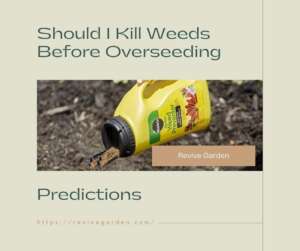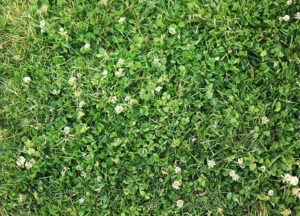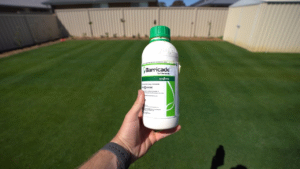Table of Contents
 Weeds are a common problem when overseeding a lawn. The good news is that it’s easy to eliminate weeds without using chemicals.
Weeds are a common problem when overseeding a lawn. The good news is that it’s easy to eliminate weeds without using chemicals.
Have you started to see weeds popping up more and more? If so, you’re not alone.
Weeds are becoming a bigger problem as the climate warms, and there are few things as frustrating as trying to rid your garden of them only to have them come back stronger than ever.
Thankfully, there are several ways to tackle weed problems before they become too big to handle. This article will discuss the common methods and why you should consider using them. Ready to get rid of those pesky weeds for good?
Should I Kill Weeds Before Overseeding – The Lesson
Before we can answer the question, “should I kill weeds before overseeding,” it’s important to know what overseeding is.
Overseeding is when you spread seed over an existing lawn to repair damaged areas or add more grass. The process usually takes place in the spring or fall, and it’s most commonly done on golf courses, parks, and other large areas where plenty of people walking around may disturb your attempts at seeding.
If you’re trying to fix a patchy part of your lawn to look more uniform with the rest of your grass (and not like something out of an episode of Hoarders), this article might help.
What are Weeds
Weeds are the bane of any lawn owner’s existence. They spread quickly, choke out your grass and make your yard look unkempt. The best way to kill weeds is by using a pre-emergent weed killer that will prevent them from growing in your yard.
A pre-emergent weed killer is a special kind of herbicide that prevents seeds from germinating and growing into mature plants. It should be used in early spring before any weeds have sprouted.
Before you apply a pre-emergent herbicide, you need to identify what type of grass you have in your lawn. You can do this by looking at the leaves or blades of grass or by pulling up a few blades and examining their roots under a magnifying glass or microscope. If you want to kill weeds naturally, try making an organic weed killer spray with vinegar and salt!
Types of weeds

To control weeds, you need to know what kind of weeds you’re dealing with. There are three basic types: annual weeds that grow from seed each year, perennial weeds that grow from roots each year and biennial weeds that live two years before bloom.
What is overseeding?
Overseeding is a gardening technique that involves scattering seeds over an existing lawn. The goal is to add new grass to your current lawn, which can help fill in spots that have become thin over time or are damaged by pests or diseases. It also allows you to change the look of your lawn by adding new colour or texture.
Best Time for Overseeding
Overseeding doesn’t require much special equipment — just some seed and a rake. But there are some things to keep in mind when planning your project:
If you’re overseeding on a warm day, it’s important not to water the area too much beforehand; this could cause the seeds to wash away before they have time to take root.
The best time of year for overseeding depends on what you’re trying to achieve. If you want green grass all year long, spring or fall is your best bet — but if you wish to yellow or brown turf during the summer months because it’s more maintenance-free, try summertime seeding instead (if possible).
Things to Consider Before Overseeding
Before you overseed, there are a few things to consider:
- type of grass you have
- type of soil you have
- type of weeds you have
- type of climate you have
- type of fertilizer you have
And many other more.
What should I do with weeds before overseeding?
Weed seeds are very small and hard to see, so they can be hard to eliminate. The best way to prevent weeds from coming back is to remove them before they set seed. This means you must kill them before they can grow larger than a few inches tall.
Herbicides
If you use herbicides, you need to know what kind of weed you’re dealing with and what type of landscape you have. The reason for this is that there are different chemicals used for different kinds of weeds.
Broadleaf weeds like dandelions and clover need broadleaf herbicides like Weed Beater or Roundup. Grassy weeds like crabgrass and goosegrass need grassy herbicides like Dithane M-45 or Ortho Weed B Gon MAX.
If you’re unsure what kind of weed you’re dealing with, spray a bit of Roundup on it and see how quickly it dies off. If it’s not dying off in a few days, it’s not a broadleaf weed!
Pulling With Hands
Pulling weeds by hand is one of the easiest ways to get rid of them before you seed your lawn. If you have large patches that need tightening, consider renting a tiller or power rake from your local rental store or garden center. These tools make removing large patches of weeds easier without damaging your grass while you pull them up by hand.
Trim with Mower
Mow them down with a weed whacker or trimmer. This is probably the easiest way to kill them off, but it doesn’t always work well when there are large patches of weeds in your yard.
Herbicide and fertilizer Combo
The other way is to use a herbicide/fertilizer combination product that goes down as one treatment. I prefer the latter because it feeds my Bermuda grass and ensures it has what it needs for strong root growth during this stressful time of year when we’re trying to grow new turf from seedlings.
Organic Weed Killer
Another option is to use an organic weed killer like vinegar or salt water. These products can kill weeds without damaging your new grass seedlings or other plants growing on your lawn.
Cautions to Use Weed Killer

Suppose you’re going to use a chemical weed killer. In that case, it’s best to wait until temperatures are above 55 degrees Fahrenheit (13 C) so that it will work effectively on the weeds without harming your existing grasses.
The best time to apply a chemical weed killer is in the morning so that it has time to dry before nightfall when you are overseeding. If you’re using a granular product and live in an area where it rains frequently, consider applying it after rainstorms so that the seeds can still germinate without being washed away by runoff from the lawnmower or sprinklers.
Final Words
There are many good reasons for killing weeds before overseeding: for starters, it keeps your yard healthier and improves its overall appearance.
It also ensures that your grass seeds will thrive instead of getting eaten by bugs or otherwise destroyed—and if you don’t do anything about those pesky weeds beforehand, they might use up all the fertilizer!
We hope you enjoyed reading this article. If you like to post your reviews and comments, please use the comment box!
